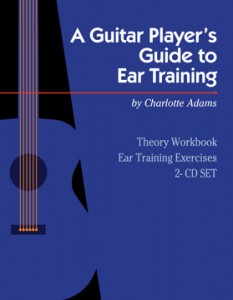One of the most satisfying things you can do as a guitar player is to use your ear to determine the chords in a song. If you’ve never figured out songs by ear, you may consider it to be a daunting task, but like all things musical, you can learn to do it by taking a step-by-step approach.
Practice singing arpeggios (chords)
Start by learning the sound of a root position major chord. Use the indicated strings on the following first position chords, which have the chord tones in root position on adjacent strings:
C – 5th string (C or “1” in the C chord), 4th string (E or “3” in the C chord), 3rd string (G or “5” in the C chord), and 2nd string (C which is “1” or when an octave higher than the starting note, “8”)
A – 3rd string (A or “1”), 2nd string (C# or “3”), and 1st string (E or “5”)
G – 6th string (G or “1”), 5th string (B or “3”), 4th string (D or “5”)
E – 4th string (E or “1”), 3rd string (G# or “3”), 2nd string (B or “5”), and 1st string (E or “8”)
Sing the arpeggios (broken chords) up and back, using the numbers of the chord tones: “1 – 3 – 5 – 3 – 1.” (It is possible to sing the octave in the case of the first position C and E chords, so if you want to do that, you will sing “1 – 3 – 5 – 8 – 5 – 3 – 1.”) Sing these chords repeatedly and often, until you can easily hear and sing the major chords in root position without using your guitar to keep you on pitch.
When you are consistently singing the chords correctly, try starting on different notes and achieving the same relative sound. In other words, pick any random note and use it as “1” when you sing the major chord arpeggio.
Practice hearing the root
The next skill to master is the ability to hear and sing the root of the chord. Strum a chord on your guitar and, without hitting individual strings, sing the note that seems like the root of the chord. Check your accuracy by playing the root of the chord on your guitar. If you were incorrect, just let your guitar guide you, sing the correct note while playing the chord, and try again with a new chord. Finish by singing the arpeggio (1-3-5-3-1).
Inversions
After you have gained proficiency in singing root position chords, you will be ready to sing inversions. In order to sing first inversion chords, you will simply start on “3” instead of “1” and will sing the chord as “3 -5 – 1 (or 8) – 5 – 3.” Practice using different chords, the same way that you did when learning to sing the chord in root position, then use the same approach for learning the second inversion. The second inversion will be sung “5 – 1 (or 8) – 3 – 1 (or 8) – 5”.
Hear the chord in a song
For the final step in your learning process, choose a chord in a song that you want to learn. Play a recording of the song and when you hear it the chord, stop the recording. It is very important to stop at the precise moment that you hear the chord, so that you can retain the sound in your ears.
Sing the notes you hear, up and back, without thought of which notes they are or how they are organized. When you are sure of the notes, find them on your guitar, so that you can name them, unscramble them and spell the chord (If you need help with this step, you can find it in A Guitar Player’s Guide to Music Theory). Alternately, you can determine the root of the chord and find it on your guitar.
Finally, play the full chord on your guitar to confirm your conclusion. Using your knowledge of chord construction and scale harmony (pages 36 and 46 of A Guitar Player’s Guide to Music Theory) will make the process easier and faster, as will a lot of practice!

If you would like to practice these skills with the help of my instruction and audio exercises, check out
A Guitar Player’s Guide to Ear Training.
All of the files in the course, along with more ear training instruction, are also available in the digital library.